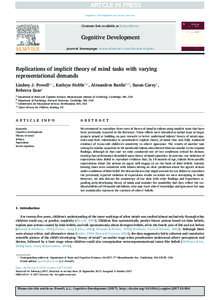<--- Back to Details
| First Page | Document Content | |
|---|---|---|
 Date: 2017-10-13 14:23:30Cognitive science Neuropsychology Theory of mind Cognition Memory Child development |
Add to Reading List |
| First Page | Document Content | |
|---|---|---|
 Date: 2017-10-13 14:23:30Cognitive science Neuropsychology Theory of mind Cognition Memory Child development |
Add to Reading List |